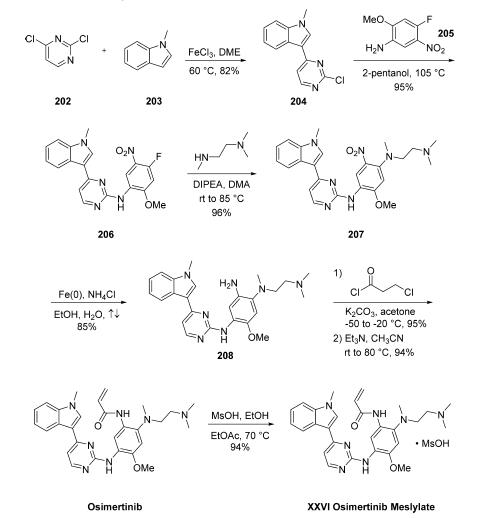| Identification | Back Directory | [Name]
Osimertinib mesylate | [CAS]
1421373-66-1 | [Synonyms]
PB1211
Tagrisso
Osimertinib
Osimertinib d6
osimertinib MsOH
Mesylate-AZD9291
AZD-9291 (Mesylate)
Mereletinib Ms salt
Osimertinib mesylate
Mereletinib mesylate
Osimeitinib mesylate
Osimertinib Impurity 30
Osimertinib Mesylate API
Undecanoicacid,15-hydroxy-
Osimertinib methanesulfonate
Osimertinib Mesylate(AZD9291)
AZD-9291 MESYLATE(OSIMERTINIB)
Osimertinib (AZD9291) mesylate
AZD9291 Ms salt, Osimertinib Ms salt
AZD-9291 mesylate (Osimertinib mesylate
Osimertinib mesylate (AZD-9291 mesylate)
AZD-9291 mesylate (Osimertinib,Mereletinib)
AZD-9291 (MESYLATE);TAGRISSO;OSIMERTINIB MESYLATE
Osimertinib Mesylate (Tagrisso, Mereletinib, AZD-9291)
Mereletinib mesylate, 98%, a potent and selective mutated forms EGFR inhibitor
MERELETINIB MESYLATE; EGFR INHIBITOR; AZD9291 MESYLATE; AZD 9291 MESYLATE;TAGRISSO
N-[2-(2-dimethylaminoethylmethylamino)-4-methoxy-5-[[4-(1-methylindol-3-yl)pyrimidin-2-yl]amino]phenyl]prop-2-enamide mesylate salt
N-2-2-(Dimethylamino)ethylmethylamino-4-methoxy-5-4-(1-methyl-1H-indol-3-yl)-pyrimidin-2-ylaminophenyl-acrylamide methanesulfonate (1:1)
N-(2-((2-(dimethylamino)ethyl)(methyl)amino)-4-methoxy-5-((4-(1-methyl-1H-indol-3-yl)pyrimidin-2-yl)amino)phenyl)acrylamide methanesulfonate
N-[2-[[2-(Dimethylamino)ethyl]methylamino]-4-methoxy-5-[[4-(1-methyl-1H-indol-3-yl)-2-pyrimidinyl]amino]phenyl]-2-propenamide methanesulfonate
N-(2-(N-(2-(dimethylamino)ethyl)-N-methylamino)-4-methoxy-5-((4-(1-methyl-1H-indole-3-yl)pyrimidine-2-yl)amino)phenyl)acrylamide methanesulfonate
N-[2-[[2-(Dimethylamino)ethyl]methylamino]-4-methoxy-5-[[4-(1-methyl-1H-indol-3-yl)-2-pyrimidinyl]amino]phenyl]-2-propenamide methanesulfonate (1:1)
2-Propenamide, N-[2-[[2-(dimethylamino)ethyl]methylamino]-4-methoxy-5-[[4-(1-methyl-1H-indol-3-yl)-2-pyrimidinyl]amino]phenyl]-, methanesulfonate (1:1)
N-(2-((2-(dimethylamino)ethyl)(methyl)amino)-4-methoxy-5-((4-(1-methyl-1H-indol-3-yl)pyrimidin-2-yl)amino)phenyl)acrylamide methanesulfonate(AZD9291 mesylate)
AZD-9291 mesylate N-[2-[[2-(Dimethylamino)ethyl]methylamino]-4-methoxy-5-[[4-(1-methyl-1H-indol-3-yl)-2-pyrimidinyl]amino]phenyl]-2-propenamide methanesulfonate (1:1)
Mereletinib mesylateQ: What is
Mereletinib mesylate Q: What is the CAS Number of
Mereletinib mesylate Q: What is the storage condition of
Mereletinib mesylate Q: What are the applications of
Mereletinib mesylate | [EINECS(EC#)]
200-064-1 | [Molecular Formula]
C28H33N7O2.CH4O3S | [MDL Number]
MFCD28137994 | [MOL File]
1421373-66-1.mol | [Molecular Weight]
595.713 |
| Chemical Properties | Back Directory | [Melting point ]
>232°C (dec.) | [storage temp. ]
-20°C Freezer, Under inert atmosphere | [solubility ]
DMSO (Slightly), Methanol (Slightly) | [form ]
Solid | [color ]
Off-White to Yellow | [InChIKey]
FUKSNUHSJBTCFJ-UHFFFAOYSA-N | [SMILES]
S(O)(=O)(=O)C.CN1C2=CC=CC=C2C(C2C=CN=C(NC3C=C(NC(=O)C=C)C(N(C)CCN(C)C)=CC=3OC)N=2)=C1 |
| Hazard Information | Back Directory | [Description]
Osimertinib is active against exon 19 deletions, exon 21 mutations, and also the
exon 20 T790M mutations. It is preferentially selective for mutated EGFR, and
therefore toxicity at therapeutic doses is lower than for first- and second-generation
agents. Notably, osimertinib is able to cross the blood-brain barrier, making it active
against disease in the CNS. | [Uses]
AZD-9291 Mesylate is a potent and selective epidermal growth factor receptor (EGFR) inhibitor. | [Application]
Osimertinib mesylate is approved to treat:
Non-small cell lung cancer that has certain EGFR gene mutations. It is used in adults:
As adjuvant therapy after surgery to remove the cancer; As the first therapy for cancer that has spread to other parts of the body, or
in patients whose cancer has spread to other parts of the body and got worse during or after treatment with another EGFR tyrosine kinase inhibitor. | [Definition]
ChEBI: A methanesulfonate (mesylate) salt prepared from equimolar amounts of osimertinib and methanesulfonic acid. Used for treatment of EGFR T790M mutation positive non-small cell lung cancer. | [Indications]
The collection of ibrutinib (Imbruvica(R), Pharmacyclics Inc.), afatinib, and osimertinib represents the small, yet expanding, group of covalent SMKIs. Ibrutinib is a non-receptor Bruton’s tyrosine kinase inhibitor approved for the treatment of relapsed chronic lymphocytic leukemia. Afatinib, approved for NSCLC in 2013 and squamous NSCLC in 2016, is a second-generation irreversible EGFR inhibitor that targets wild-type EGFR, the mutant T790M EGFR, and HER2. Osimertinib (AZD9291), which was approved by FDA in November 2015, is a third-generation irreversible EGFR inhibitor that selectively targets the mutant T790M EGFR. Rociletinib, which shares a high degree of structural similarity with that of osimertinib, is a promising covalent EGFR inhibitor developed by Clovis Oncology aimed for the treatment of patients with EGFR T790M-mutated NSCLC, until the company terminated its development in May 2016 following a negative vote fromthe FDA’sOncologic Drugs Advisory Committee. | [Brand name]
TagrissoTM
| [General Description]
Class: receptor tyrosine kinase
Treatment: NSCLC
Oral bioavailability = 70%
Elimination half-life = 48 h
Protein binding = 94.7% | [Side effects]
Osimertinib toxicity is dose-dependent and is associated with fewer gastrointestinal
and dermatologic adverse events than with other approved EGFR TKIs. | [Synthesis]
Friedel-Crafts arylation of commercial N-methylindole
(203) with commercial dichloropyrimidine 202 gave the 3-
pyrazinyl indole 204 in good yield. Subsequent SNAr with
nitroaniline 205 (available from a one-step nitration from the
commercially available des-nitroaniline) provided aminopyrazine
206. Next, SN
Ar reaction of 206 with N,N,N??-
trimethylated ethylenediamine delivered 207 in near quantitative
yield, and this was followed by nitro reduction with iron
under acidic conditions to give rise to the triaminated arene
208 in 85% yield. Because acrylates are notoriously difficult to
install directly due to their highly reactive nature and
propensity to polymerize, a clever two-step acylation/
elimination sequence was employed using 3-chloropropanoyl
chloride, and this was immediately followed by mesylate salt
formation, which furnished the osimertinib mesylate (XXVI) in
excellent yield. This seven-step process which derives from
readily available feedstock delivered the final product in nearly
57% overall yield from starting materials 202 and 203.
 |
|
|